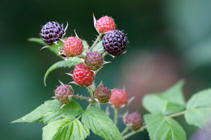Pam Van Pelt
Adam's County Master Gardener Program
 As we move into the heat of the summer, the time to pick berries is upon us. Why not pack up the family and visit a local pick your own farm? It’s the
best way to get the freshest and most delicious berries while enjoying the great beauty of our area. Fresh berries have a very short shelf life, so it’s best to eat them soon
after you pick them or freeze them for use at a later time. There are a number of websites with great recipes for fresh berries. Not only do you have the fun of picking your
own fresh berries, but you can enjoy the delicious pies, jams and sauces they make.
As we move into the heat of the summer, the time to pick berries is upon us. Why not pack up the family and visit a local pick your own farm? It’s the
best way to get the freshest and most delicious berries while enjoying the great beauty of our area. Fresh berries have a very short shelf life, so it’s best to eat them soon
after you pick them or freeze them for use at a later time. There are a number of websites with great recipes for fresh berries. Not only do you have the fun of picking your
own fresh berries, but you can enjoy the delicious pies, jams and sauces they make.
Do you know the answers to these questions?
What are brambles?
Brambles are thorny plants that are members of the Rose family with perennial roots and biennial stems. They include raspberries, blackberries,
dewberries and loganberries. The ‘Loganberry’ is an early raspberry-blackberry hybrid. Dewberries are trailing plants closely related to blackberries.
What is the difference between raspberries and blackberries?
Raspberries come in red, yellow, black or purple with red and yellow being the most cold hardy of all brambles. Raspberries produce either one or two
crops per year, while blackberries are summer bearing. Summer bearing produces one crop in early to mid summer while fall bearing, also known as everbearing, produces a crop
in mid summer and a second crop in late summer or early fall. The aggregate fruit is made up of small drupelets that form on the outside of a core. When a raspberry is
picked, it separates from the core and is hollow inside while blackberries detach with the core inside them.
How are they pollinated?
Nearly all brambles are self fruitful with 90% of the pollination done by honeybees. After pollination, the fruit requires from 30 to 45 days to
mature.
What is the difference between a floricane and a primocane?
During the first year of growth, the canes are known as primocanes, generally producing only leaves and buds for the following year‘s flowers.
Floricanes are second season growth that produces flowers and fruit. After fruiting, the floricanes die and are replaced by new primocanes.
How do you prune raspberries and blackberries?
 Primocanes of black raspberries and purple raspberries should be tipped at 18 to 20 inches causing branching that will produce and support more fruit.
When the new buds of the floricane break in the spring, the side branches should be shortened to 8 to 12 inches. When done fruiting, cut the cane to the ground to prevent
disease.
Primocanes of black raspberries and purple raspberries should be tipped at 18 to 20 inches causing branching that will produce and support more fruit.
When the new buds of the floricane break in the spring, the side branches should be shortened to 8 to 12 inches. When done fruiting, cut the cane to the ground to prevent
disease.
Primocanes of red raspberries should be left unpruned the first year; and at the beginning of the second year, the floricanes should be cut to a
height that will allow them to support themselves or trellis them.
Blackberries (upright varieties) should be pruned when the primocanes reach 3 to 4 ft. Pinch or cut 3 to 4 inches off their tips to encourage side
branching. As growth starts, cut the side branches of the floricanes back to 12" to 15". Remove all dead or weak canes. When done fruiting, cut cane to the ground.
What are the wildlife benefits?
In addition to providing cover, brambles serve as nesting places for warblers, finches, thrushes, wrens, robins, catbirds and blackbirds. The flowers
are an important food source for butterflies, hoverflies, bumblebees, wasps, flies and lacewings. The leaves are an important food source for the larvae of many moths and
butterflies, and the fruit is a food source for robins, catbirds, starlings, thrushes, blackbirds, pheasants, foxes, mice and other mammals.
What do they need to thrive?
Before planting brambles, take a soil sample to your local extension office and amend soil accordingly. Brambles need full sun, a well drained, deep
sandy loam with plenty of humus and a pH range of 5.8 to 6.5. Avoid windy sites to protect the canes. Do not plant brambles where you have previously grown peppers, eggplant,
tomatoes or potatoes. These crops may harbor a fungus (Verticillium Wilt) that can kill raspberry roots.
What grows best in our area?
- Red Raspberries - Boyne, Canby, Killarney, Latham, Nova, Reveille, Taylor, Titan,
- Autumn Bliss, Autumn Britten, Caroline, Dinkum, Heritage
- Yellow Raspberries - Anne, Fallgold, Goldie, Kiwigold
- Black Raspberries - Allen, Bristol, Cumberland, Jewel, and Munger
- Purple Raspberries - Brandywine and Royalty
- Blackberries - Thornless - Arapaho, Chester, Navaho, and Triple Crown.
- Blackberries - Thorny - Darrow, Illini Hardy, and Kiowa.
Read other articles on ecological gardening & native plants
Read other article by Pam Van Pelt